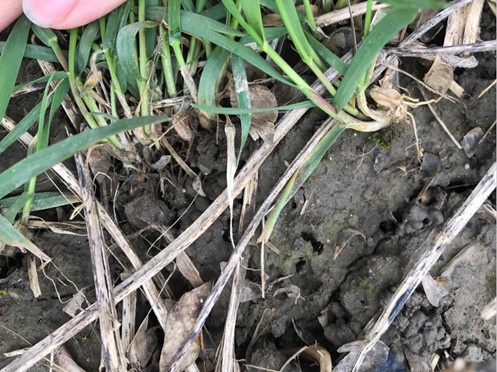Winterkill
Winter cereals can be destroyed during the winter and early spring period by frost heaving, ice, low temperatures, and snow mould. Varieties differ in their ability to withstand these different winter stresses. This explains the regional adaptation of some varieties that may not perform well across the province.
Select the varieties to address the winterkill concerns for specific areas, when choosing your variety to plant. Varieties grown in the Ottawa Valley need ice tolerance; those grown in the Lake Huron snow belt need snow-mould tolerance, while those grown in the heavy clays of Essex, Lambton and the Niagara peninsula need resistance to frost heaving.
Refer to the replanting section and Table 4–6, Determining yield potential for various plant stand counts for information on assessing the winter wheat crop stand and making a replant decision.
Frost Heaving
The freeze/thaw cycles of early spring are one of the main reasons for winterkill in Ontario. The risk is highest in heavy-textured soil and/or soils with limited sub-surface drainage. As frost goes into the ground, it works under the crown and “lifts” the plant up. See Plate 28. If these freeze/thaw cycles are repeated, the plant is ejected or “jacked” out of the soil. Roots are broken and left exposed above the soil, causing death of the plant due to desiccation. This process is referred to as frost heaving.

Photo 4-8. Frost heaving of winter wheat is caused by freeze/thaw cycles of early spring, lifting up the crown.
Deep-seeded wheat is not more resistant to frost-heaving injury. The primary root system does not anchor the plant in the soil. The secondary root system anchors the wheat plant in the soil, protecting against frost-heaving injury. The secondary root system of the wheat plant cannot develop deeper in the soil than the depth of the seed, see Figure 4–1, Days to emergence at various seeding depths. When wheat is seeded deep, the plant develops the crown and secondary root system at about 2–2.5 cm (0.75–1 in.) deep, as the crown develops in response to light. Regardless of planting depth, the secondary roots will not develop below 2.5 cm (1 in.). To maximize resistance to frost heaving, wheat plants need an extensive secondary root system developed as deep as possible.
In frost heaving prone soils, increased seeding rate can also reduce damage. At higher seeding rates, and with some root growth, roots “interlock” and plants are more resistant to frost heaving action.
Ice
When there is a rapid snow melt or winter rain is followed by below-freezing temperatures, ice can form as a thick sheet across ponded areas. Even when the water is able to drain away below the ice sheet, the ice itself may prevent oxygen from getting to the plants and the wheat will suffocate and die below the ice.
Surface and subsurface drainage can help reduce the ponding, which leads to this problem. Should an ice sheet form (for example, during January and February), dormant wheat will only survive for approximately 2 weeks. Break the ice surface to allow gas exchange and to keep the wheat alive: be careful, as there may be deep water under the ice. In some situations, compaction from combine tires results in sufficient depressions and reduced drainage resulting in icing that will occur in the combine wheel tracks only. Low pressure tires or tracks on combines can reduce compaction sufficiently to prevent this problem.
Cold Injury
Wheat will survive extremely cold temperatures before plant death occurs. Plants that have “hardened off” (gone dormant) can survive temperatures down to -24°C. Snow cover acts to insulate the crop from extremely cold temperatures, and even 7.5 cm (3 in.) of snow is sufficient to protect the crop from colder temperatures. Leaf tissue on plants that have not hardened off will withstand -9°C, making late spring frosts of little consequence. There was only 1 year in the last century (1900–1999) when cold temperatures destroyed the wheat crop in Ontario.
While the wheat crop survives cold temperatures well, cold injury can reduce vigour and final yield. In severe winterkill situations, marginal areas suffering cold injury may not rebound as expected. However, this phenomenon is impossible to predict.